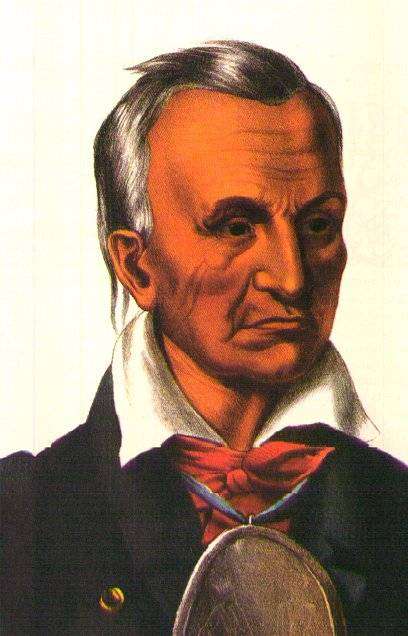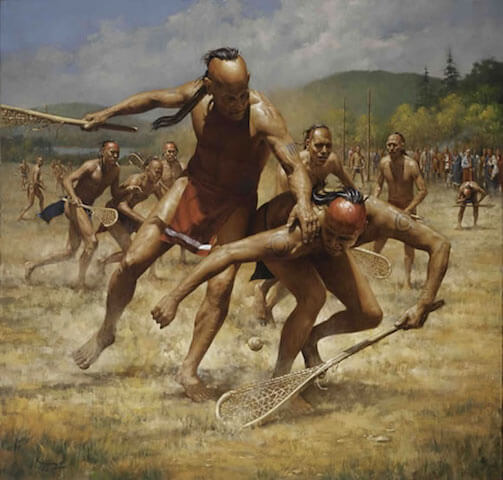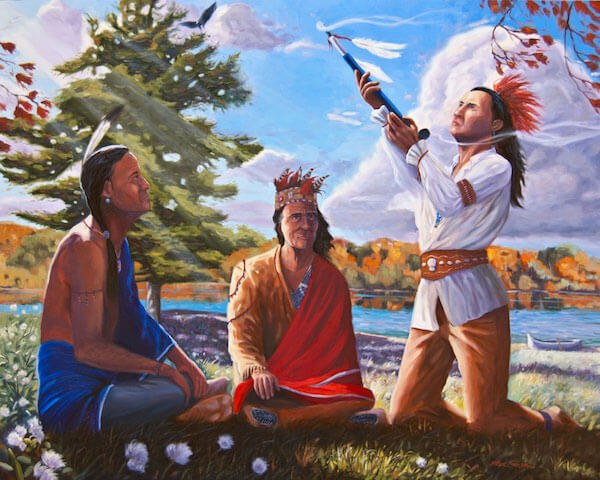To view this page in another language, please click here:
Iroquois
Literature
(Haudenosaunee)
When Europeans first arrived in North America, the Haudenosaunee were based in what is now the northeastern United States, primarily in what is referred to today as upstate New York west of the Hudson River and through the Finger Lakes region. In 1995, more than 50,000 enrolled Six Nations people lived in Canada, and about 30,000 in the United States. After the defeat of the British and their Iroquois allies in the American Revolutionary War, most migrated to Canada and their descendants live there.
The Iroquois are a mix of horticulturalists, farmers, fishers, gatherers and hunters, though their main diet traditionally has come from farming. The main crops they cultivated are corn, beans and squash, which were called the three sisters and are considered special gifts from the Creator. These crops are grown strategically. The cornstalks grow, the bean plants climb the stalks, and the squash grow beneath, inhibiting weeds and keeping the soil moist under the shade of their broad leaves. In this combination, the soil remained fertile for several decades. The food was stored during the winter, and it lasted for two to three years. When the soil eventually lost its fertility, the Haudenosaunee migrated.
The Iroquois believe that the spirits change the seasons. Key festivals coincided with the major events of the agricultural calendar, including a harvest festival of thanksgiving. The Great Peacemaker (Deganawida) was their prophet. After the arrival of the Europeans, many Iroquois became Christians, among them Kateri Tekakwitha, a young woman of Mohawk-Algonquin parents. Traditional spirituality was revived to some extent in the second half of the 18th century by the teachings of the Haudenosaunee prophet Handsome Lake.
"Those
who have one foot in the canoe and
one foot in the boat are going to fall in the river."
Tuscarora Saying
The
Iroquois call themselves the Haudenosaunee, which means
"People of the
Longhouse," or more accurately, "They Are Building a Long
House."
According to their tradition, The Great Peacemaker
introduced the name
at the time of the formation of the League. It implies
that the nations
of the League should live together as families in the same
longhouse.
Traditionally, Kanien'kehá:ka (Mohawk) are the guardians
of the eastern
door, as they are located in the east closest to the
Hudson, and the
Seneca are the guardians of the western door of the
"tribal longhouse",
the territory they controlled in present-day New York.
Onöñda’gega’ (Onondaga), whose homeland is in the center
of Haudenosaunee territory,
are keepers of the League's (both literal and figurative)
central flame.
The
Grand Council of the Iroquois League is an assembly of 56
Hoyenah
(chiefs) or Sachems, a number that has never changed.
Today, the seats
on the Council are distributed among the Six Nations as
follows:
Iroquois
Confederacy
(Haudenosaunee)
10 Cayuga
9 Oneida
9 Mohawk
8 Seneca
6 Tuscarora
The original homeland of the Iroquois was in upstate New
York between the
Adirondack Mountains and Niagara Falls. Through conquest and
migration,
they gained control of most of the northeastern United
States and
eastern Canada. At its maximum in 1680, their empire
extended west from
the north shore of Chesapeake Bay through Kentucky to the
junction of
the Ohio and Mississippi Rivers; then north following the
Illinois
River to the south end of Lake Michigan; east across all of
lower
Michigan, southern Ontario and adjacent parts of
southwestern Quebec;
and finally south through northern New England west of the
Connecticut
River through the Hudson and upper Delaware Valleys across
Pennsylvania
back to the Chesapeake. With two exceptions - the Mingo
occupation of
the upper Ohio Valley and the Caughnawaga migration to the
upper St.
Lawrence - the Iroquois did not, for the most part,
physically occupy
this vast area but remained in their upstate New York
villages.
During the hundred years preceding the American Revolution,
wars with
French-allied Algonquin and British colonial settlement
forced them
back within their original boundaries once again. Their
decision to
side with the British during the Revolutionary War was a
disaster for
the Iroquois. The American invasion of their homeland in
1779 drove
many of the Iroquois into southern Ontario where they have
remained.
With large Iroquois communities already located along the
upper St.
Lawrence in Quebec at the time, roughly half of the Iroquois
population
has since lived in Canada. This includes most of the Mohawk
along with
representative groups from the other tribes. Although most
Iroquois
reserves are in southern Ontario and Quebec, one small group
(Michel's
band) settled in Alberta during the 1800s as part of the fur
trade.






